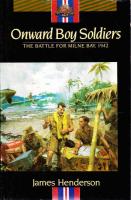AUSTRALIAN MILITARY
ix, 250 p. : ill. ; 23 cm. First edition. The account of the Japanese advance in New Guinea and its interdiction by the Australians at Milne Bay, with recollections from those on who fought on both sides.
The Battle of Milne Bay (25 August – 7 September 1942), also known as Operation RE by the Japanese, was a battle of the Pacific campaign of World War II. Japanese naval troops, known as Kaigun Rikusentai (Special Naval Landing Forces), attacked the Allied airfields at Milne Bay that had been established on the eastern tip of New Guinea. Due to poor intelligence work, the Japanese miscalculated the size of the predominantly Australian garrison and, believing that the airfields were only defended by two or three companies, initially landed a force roughly equivalent in size to onebattalion on 25 August 1942. The Allies, forewarned by intelligence from Ultra, had heavily reinforced the garrison.
Despite suffering a significant setback at the outset, when part of the invasion force had its landing craft destroyed by Allied aircraft as they attempted to land on the coast behind the Australian defenders, the Japanese quickly pushed inland and began their advance towards the airfields. Heavy fighting followed as they encountered the Australian Militiatroops that formed the first line of defence. These troops were steadily pushed back, but the Australians brought forward veteran Second Australian Imperial Force units that the Japanese had not expected. Allied air superiority helped tip the balance, providing close support to troops in combat and targeting Japanese logistics. Finding themselves outnumbered, lacking supplies and suffering heavy casualties, the Japanese withdrew their forces, with fighting coming to an end on 7 September 1942.
The battle is considered to be the first in the Pacific campaign in which Allied troops decisively defeated Japanese land forces. Although Japanese land forces had experienced local setbacks elsewhere in the Pacific earlier in the war, unlike at Milne Bay, these actions had not forced them to withdraw completely and abandon their strategic objective. As a result of the battle, Allied morale was boosted and Milne Bay was developed into a major Allied base, which was used to mount subsequent operations in the region.
#141221R/081222 (Name on half-title)
